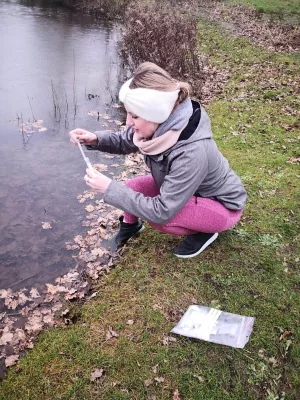
Karolina Brylka
Doctoral student

Early Paleogene biosiliceous sedimentation in the Atlantic Ocean : Testing the inorganic origin hypothesis for Paleocene and Eocene chert and porcellanite
Author
Summary, in English
The widespread occurrence of lower Eocene chert and porcellanite has been viewed as a major paleoceanographic issue since the advent of ocean drilling, and both biotic and abiotic forcings have been proposed to explain it. We present a reconstruction of indurated siliceous sediment (ISS) and preserved biosiliceous sediment (PBS) occurrences in the Atlantic Ocean through the Paleocene and Eocene (~66 through 34 Ma). ISS and PBS distributions reveal dissimilar temporal trends, with the peak of ISS occurrences coinciding with the Early Eocene Climatic Optimum, in line with previous studies. PBS occurrences show a generally increasing trend culminating between 44 and 43 Ma. The common co-occurrence of ISS and PBS, and their coherent geographic distribution lends strong support to the biogenic origin of the precursor to the widespread Paleogene ISS, and argues against an inorganic mode of early Cenozoic chert and porcellanite precipitation. Weight per cent biogenic opal records and trends in linear sedimentation rates indicate two plausible modes of silicification: 1) silicification due to prolonged exposure of biogenic opal-rich sediments to corrosive bottom waters; and 2) silicification due to elevated pressures and temperatures caused by rapid burial of biogenic opal-rich deposits. The confinement of ISS and PBS to proximal sites along continental margins points to the reliance of siliceous sedimentation through the Paleocene and Eocene on terrestrial supply of dissolved silicon. Consistent with this, quantitative siliceous microfossil assemblage records from the Blake Nose in the NW Atlantic indicate that the nutrient-rich marginal rather than oligotrophic pelagic settings hosted the majority of siliceous plankton production through the early Paleogene. The inorganic SiO2 precipitation model is unlikely to have been the dominant mechanism responsible for ubiquitous occurrences of early Paleogene ISS. We favor the biogenic ISS precursor scenario and reconcile it with the low-productivity early Cenozoic oceans by showing that large volumes of biogenic silica were supplied to the western North Atlantic Ocean from the North American margin through the Paleocene and Eocene. Dissolution of this surplus silica was facilitated by an early southwestward flow of young, SiO2-depleted waters from the North Atlantic. All these factors contributed to ISS and PBS focusing in the western North Atlantic through the early Paleogene.
Department/s
- Lithosphere and Biosphere Science
- Quaternary Sciences
Publishing year
2020
Language
English
Publication/Series
Palaeogeography, Palaeoclimatology, Palaeoecology
Volume
556
Document type
Journal article
Publisher
Elsevier
Topic
- Geology
Keywords
- Biogenic silica
- Blake Nose
- Diagenesis
- Diatoms
- Ocean drilling
- Paleoceanography
Status
Published
ISBN/ISSN/Other
- ISSN: 0031-0182

